Aloe ecklonis
Aloe ecklonis Salm-Dyck
Family: Asphodelaceae
Common names: Ecklon’s aloe, grass aloe (Eng.), Ecklonse-aalwyn, vlei-aalwyn, grasaalwyn (Afr.), hloho-tsa-makaka, lekxalana, maroba lihale (Sesotho), isiphukuthwane, isiphuthumane (isiZulu)
Introduction
Aloe ecklonis is a tough and beautiful succulent, that boasts striking rosettes of broad leaves and vibrant orange, yellow or salmon-pink flowers in summer, adding a burst of colour to the garden. These blooms aren't just visually striking, but attractive to pollinators as well, making Aloe ecklonis a beneficial addition to your ecosystem.
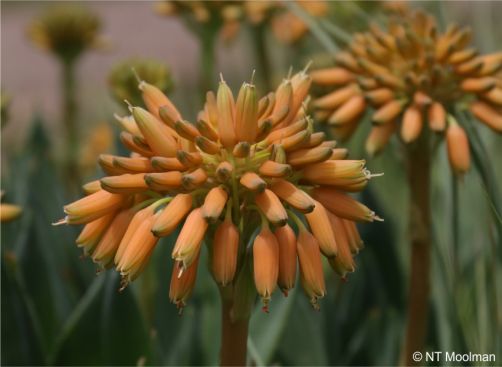
Description
Description
Aloe ecklonis is a stemless or short-stemmed, fast growing, evergreen, succulent plant 0.5-1 m tall. Leaves are up to 400 x 100 mm, blue-green to emerald-green, broad, sword-shaped, the margins with white triangular teeth. Inflorescences are rounded clusters at the tip of short flowering stems, made up of many, about 24 mm long, tubular flowers, in shades of lemon-yellow, orange, salmon-pink and rarely red. Flowers are present in midsummer, from November to January. Fruit is a brown or grey capsule, up to 35 x 13 mm.
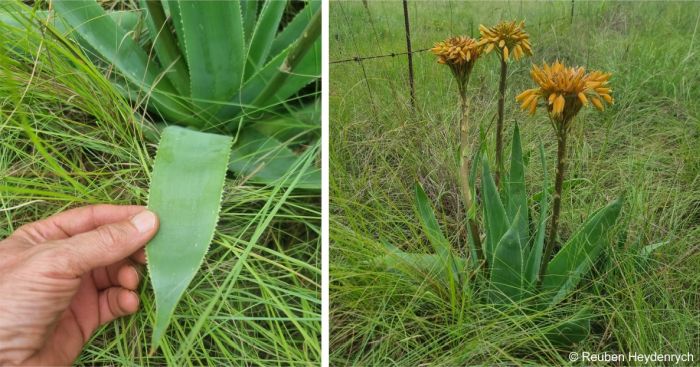
Conservation Status
Status
Aloe ecklonis is a very common and widespread species and is assessed as Least Concern (LC), by the Red List of South African Plants.
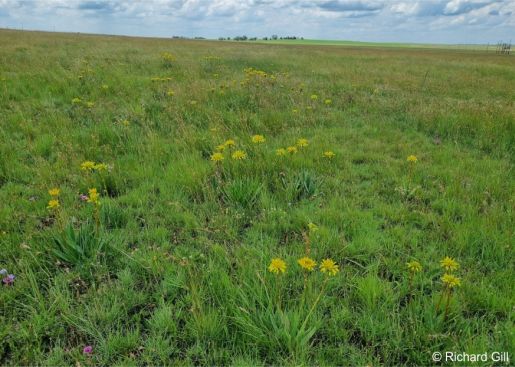
Distribution and habitat
Distribution description
Aloe ecklonis occurs from the Eastern Cape northwards through the KwaZulu-Natal interior and eastern Free State to the Mpumalanga Highveld in South Africa. It also occurs in Eswatini and Lesotho. It occurs in highly variable habitats, but generally prefers heavy clay soils in grassland. It occurs in both moist and dry, well-drained sites, and from near sea level to very high altitudes in the Drakensberg. It is often found in severely degraded and disturbed species-poor grasslands as well as in areas under heavy alien infestation.
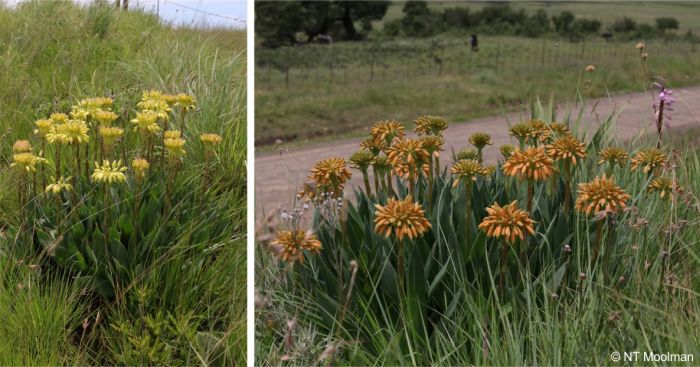
Derivation of name and historical aspects
History
The origin of the genus name may stem from the Arabic words alloch or alloeh, which were their common names for Aloe species used in traditional medicine. The species name ecklonis honours a Danish chemist and botanical explorer C.F. Ecklon (1798-1868), who first sent seeds of this species to Europe in 1836. The genus Aloe has more than 500 species of shrubby succulents in the Asphodelaceae family. It is native to Africa, the Arabian Peninsula, India and Madagascar. Aloes are valued for the medicinal properties of their leaves and their aesthetic appeal.
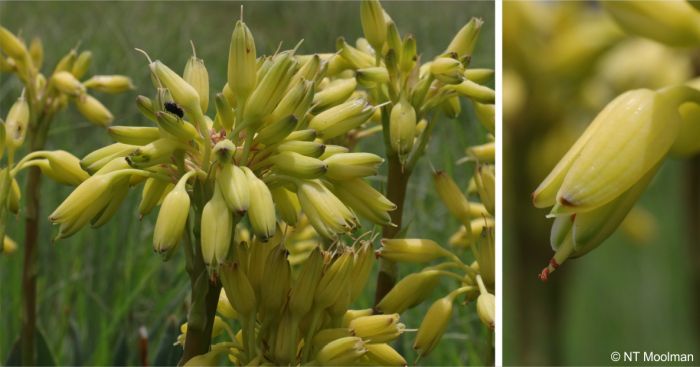
Ecology
Ecology
Aloe ecklonis flowers attract both sunbirds and insects, including honey bees. Sunbirds come to drink the nectar, while insects seek out both the nectar and pollen.
Uses
Use
Aloe ecklonis is versatile and attractive in landscaping, suitable for grassland gardens, ornamental beds, or pots. It thrives in damp grassland environments. It has medicinal and magical uses. Some believe it can ward off misfortune. In Basotho culture, it is thought to have the power to transform enemy bullets into harmless water. The plant is also used medicinally, particularly for respiratory, reproductive and digestive purposes.

Growing Aloe ecklonis
Grow
Aloe ecklonis, can be propagated through several methods. The most reliable approach is removing offsets that develop around the base of the parent plant. When these offsets reach about one-third the size of the parent, they can be carefully separated, allowed to dry for a few days, and then planted in well-drained soil. Seed propagation is another option, involving collecting seeds from mature capsules and sowing them in a warm, slightly moist, free-draining soil mix, with germination typically occurring within 2-4 weeks. Leaf cuttings can also be attempted by cutting a healthy leaf at the base, allowing it to callus, and then planting it in slightly moist, well-drained soil. Regardless of the method chosen, providing proper care and suitable growing conditions is crucial for successful propagation.
Aloe ecklonis is easy to grow and adaptable. Grow it in a sunny position, in well-drained soil. It will do well on a well-watered site, or one that gets moderate water in summer, and will survive a dry winter. It is frost hardy.
Aloe ecklonis, like other aloes, is generally hardy but can be susceptible to certain diseases. The most common issues include: root rot, caused by poor drainage or overwatering, which manifests as soft stems and yellow leaves. Leaf spot, a fungal infection often due to high humidity, appears as brown or black spots on leaves. Aloe rust, another fungal disease, produces orange or brown pustules on leaves. Soft rot, a bacterial infection, results in water-soaked, mushy areas on leaves or stems. Pests such as mealybugs and scale insects are common pests that can weaken the plant and lead to secondary infections. Prevention involves ensuring proper drainage, avoiding overwatering, providing good air circulation, and using sterile tools when propagating or pruning. Treatment typically includes improving growing conditions, removing affected parts, and potentially using appropriate fungicides or insecticides.
References
- Gill, R. 2023-12. Observation of Aloe ecklonis, Sedibeng District, Gauteng. iNaturalist. Online. https://www.inaturalist.org/observations/195281456.
- Glen, H.F. & Hardy, D.S. 2000. Aloaceae (First part): Aloe. In: G. Germishuizen (ed.), Flora of Southern Africa, Vol. 5, Part 1, Fasc. 1: 1–159. National Botanical Institute, Pretoria.
- Grace, O.M., Klopper, R.R., Figueiredo, E. & Smith, G.F. 2011. The aloe names book. Strelitzia 28: i–viii.; 1–232. South African National Biodiversity Institute, Pretoria and the Royal Botanic Gardens, Kew.
- Heydenrych, R. 2023-12. Observation of Aloe ecklonis, Vryheid Ladysmith area, Free Stat. iNaturalist. Online. https://www.inaturalist.org/observations/194772772.
- Moolman, N.T. 2022-12. Observation of Aloe ecklonis, Volksrust area, Mpumalanga. iNaturalist. Online. https://www.inaturalist.org/observations/220913948.
- Moolman, N.T. 2022-12. Observation of Aloe ecklonis, Volksrust area, Mpumalanga. iNaturalist. Online. https://www.inaturalist.org/observations/220913939.
- Mtshali, H., Victor, J.E. & Von Staden, L. 2018. Aloe ecklonis Salm-Dyck. National Assessment: Red List of South African Plants. Accessed on 2024/06/21.
- Peter, C. 2023-02. Observation of Aloe ecklonis, Hogsback, Eastern Cape. iNaturalist. Online. https://www.inaturalist.org/observations/148911405.
- Pole Evans, I.B. 1937. Aloe ecklonis Salm-Dyck. The Flowering Plants of South Africa 16: t. 609.
- Random Harvest. Aloe ecklonis. https://www.randomharvest.co.za/South-African-Indigenous-Plants/Show-Plant/PlantId/830&Plant=Aloe-ecklonis. Accessed 14/06/2024.
- Van Wyk, B. & Smith, G.F. 2014. Guide to the aloes of South Africa. Briza Publications, Pretoria.
- Wentzel, J. n.d. Aloe ecklonis. Wild Flower Nursery. Online. https://wildflowernursery.co.za/indigenous-plant-database/aloe-ecklonis/. Accessed 14/06/2024.
Credits
Lesego Maunatlala and Ingrid Mudau
Pretoria National Botanical Garden
November 2024
Acknowledgements: the authors thank N.T. Moolman, Richard Gill, Reuben Heydenrych and Craig Peter for providing the photographs.
Plant Attributes:
Plant Type: Shrub
SA Distribution: Eastern Cape, Free State, KwaZulu-Natal, Mpumalanga
Soil type: Clay, Loam
Flowering season: Early Summer
PH:
Flower colour: Red, Pink, Yellow, Orange
Aspect: Full Sun, Morning Sun (Semi Shade), Afternoon Sun (Semi Shade)
Gardening skill: Easy
Special Features:
Horticultural zones










Rate this article
Article well written and informative
Rate this plant
Is this an interesting plant?
Login to add your Comment
Back to topNot registered yet? Click here to register.